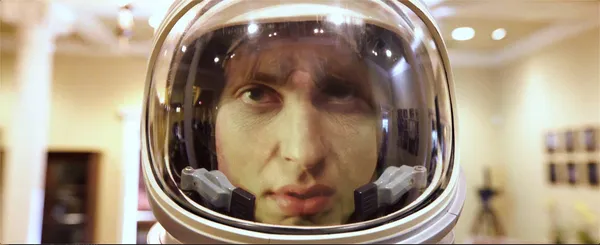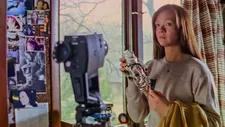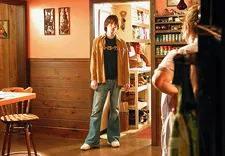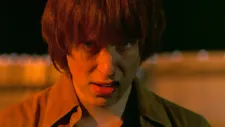 |
| John Francis Daley as the young Patrick Read Johnson in 5-25-77 |
Patrick Read Johnson has a claim to fame which thousands envy. He was the first person, beyond those who made it, ever to see the original Star Wars. The story of how that came about is the lynchpin of his semi-autobiographical new film, 5-25-77, which also explores the way he fell in love with filmmaking and finally moved beyond amateur productions in small town Illinois to develop a career in the industry. If you imagine what an almost 60-year-old lifelong fan of science fiction cinema might look like, you’ll have no difficulty picturing Patrick, but it shines out of him in a good way, his creative passion visible in everything he says and does. We almost missed out on having this conversation because a falling tree cut off his Wi-fi at the last minute, but consummate professional that he is, he legged it down the road to an accommodating Chinese restaurant where he could find a quiet corner to chat. he has always had to be good at contingency planning and perseverance.. Although he got a good number of other films under his belt in the meantime, 5-25-77 took him more than two decades to make.
“It's true,” he says. “Gary Kurtz, who produced Star Wars and American Graffiti, The Empire Strikes Back and a number of other films, became a friend of mine early on in my career, and actually shared offices with me at Universal Studios. We were developing lots of different things. We'd go to lunch and toss story ideas around and I had had this idea of Goodbye Yellow Brick Road, which was essentially American Graffiti for the Seventies. Just my high school experience chopped up into little episodes, kind of like George's a decade later. Gary said ‘Of course, I know why you want to do it. We all want to do our American Graffiti, but that's just not me. I've already done one, and it's just not my era.’ I said ‘Well, can I tell you one little detail I left out?’ And he goes ‘Yeah,’ so I told him what happened to me in Hollywood.
 |
| Filmmaking takes a team |
“His jaw fell off. He said ‘Why didn't you tell me that before?’ I said I didn't know if he’d believe me. And he goes ‘No, hang on - when did you see Star Wars? I told him the exact date, and he goes ‘Okay, well, then you're the first person that didn't actually work on it to ever see a frame of it. You’re fan number one.’ Then we started developing it.
“That was 1999. We got $120,000 and we shot about 70%, we shot everything up to what happens in Hollywood. And then the financier ran out of money. So we then spent two years with this movie cut together that had everything in Wadsworth Lake County, and then this big slug of 25 minutes that said ‘Patrick goes to Hollywood.’ It took us two years and then we finally found some amazing folks that decided to put in the rest of the money we needed to shoot all of that. And that was 2006, we shot the Hollywood portion. And then things went crazy, because the serious distributors and agencies got excited about it. But Star Wars was kind of waning by them. The prequels had come out, come and gone, and people thought ‘Well, that's probably the end of Star Wars as a giant thing.’
“I actually knew because I had so many friends at Lucasfilm, that there was a lot more coming down the pipe, but I couldn't say a word about it or I’d be excommunicated. Even to raise money I couldn't whisper about it. So it took a long time fighting a lot of resistance from people who just thought we missed our chance, to finally get the money to finish it. And we got into some festivals, but we couldn't get anybody to pay for the music. There's a lot of really good music in this movie, and it's not fake, it's not remakes. It's the real stuff.
“Alan Parsons was involved and knew most of the bands personally and I was friends at high school with the head of the legal department for Universal Music, and the movie made these musicians very happy, but it was still going to cost us about $200,000 with everybody chipping in. And no one was willing to do it. They just said ‘Take the songs out or put some fake ones in or whatever. But there was this guy Eric Wilkinson who’d been following the movie for ten years. Every year he'd say ‘Can I distribute the movie?’ We’d say ‘Do you have here $2,000?’ ‘Nope.’ And then finally he got the money and we were back in business.”
I suggest that even the delays of a year or two in filming must have been a worry given that his stars were very young at the time and liable to change quite a bit, but he says that most of what they still had to do at that stage was effects work and miniature work, and that they were also able to repurpose some of the footage they had already shot.
“We had five hours worth of material to work with. Most indie films barely get enough to cut one movie together. We got enough that if we did the two sequels, we could still have flashbacks. So there are two sequels being contemplated. One is called 5-25-90: The Empire Strikes Pat, about my character’s time living and working in Hollywood before he quits in disgust and goes back to Wadsworth. And then there's 5-25-04:Returning Of The Alumni, in which is my high school friends and my movie friends get together in Wadsworth, Illinois to start making 5-25-77.”
There’s certainly enough story about it to do that, I note. But how close is what we see in this first film to his real life story?
 |
| Setting up the shot |
“The weirder and crazier the event in the movie, the truer it is,” he says. “The stuff that's not true is the interstitial yarn I'm using to weave together these bigger moments, from three years’ worth of events crushed down to one. There's a lot of fantasy, obviously, involved in stuff when he's in his hometown. From the time he gets to Herb Lightman’s office to the time he leaves, there's not a single moment that isn't exactly as it occurred. That part of it is burned into my DNA.
“I very consciously made the choice that this kid's life, before he goes to Hollywood, is very frenetic, very disjointed, very uneven. He's ADHD. He doesn't slow down enough to to see what he should be really seeing at the time, emotionally, intellectually, practically. He's always looking for the next synaptic firing, the next impulse, right? Then he gets to Hollywood and everything slows to a very staid widescreen, proper lenses, proper film stock, you know? And the cutting is very slow and deliberate, and more cinematic. When it comes back to Illinois, it starts to get wacky again, until he starts to apply what he learned in Hollywood to actually observing what's going on around him thinking instead of just reacting.
“He can have as much fantasy as he wants when he's dreaming about the Hollywood he's never been to, and then the cold reality hits him right between the eyes. In that sequence there’s nothing artificial, except for that one moment when he's looking down a little forced perspective country road and there's the Duel truck sitting there rumbling, threatening him with doom. That allowed me to be as fantastical as I wanted in the home bound sequences, and ironically, no whimsy, no fantasy of any kind when we're in dreamland, in Hollywood.”
Because that's what the dreams are made instead of where they're watched?
He nods, and we go on to discuss some of the films referenced in 5-25-77.
“2001, obviously, was the thing I saw when I was six years old that just changed the way I saw the universe and saw my future. Of course, at the time, I had no idea what a director did. Nor did I have much idea what a screenwriter did. There's not even any dialogue for the first 30 minutes of the movie anyway. I was fascinated with the spacecraft. It was the height of the space age: 1968. I was allowed to stay home from school to watch Apollo launches because I was so into all that.
“I believed that Stanley [Kubrick] made that. I didn't know it was a guy named Douglas Trumbull. He did most of what everybody said Stanley did. Trumbull had a great deal to do with all of that, and later became a good friend of mine. And I can't thank the Kubrick family enough because we're only the second film in history to be allowed to use actual footage from 2001 in a narrative, non-documentary drama, which was really nice of them.
“People think it's my favourite film and and other people think maybe my favourite film is Star Wars. The truth is my favourite film is Close Encounters Of The Third Kind, for a lot of reasons, but, you know, 2001 was the one that inspired me to get into film, and I still count it right up there. It's my second favourite film, Star Wars is my third favourite film, and for all for different reasons that are fairly apparent if you've seen the movie – you know what each of them does to my character. I don't want to give that away because it's a lovely realisation at a certain point, if you're watching carefully.”
When the fictionalised version of him visits Industrial Light and Magic, we see a lot of the model work used in Star Warts. I ask him about that side of the film and about his career in making models for films like Warlock and Bill And Ted’s Excellent Adventure.
 |
| "I know what it's like to be a teenager" |
“I started out in visual effects,” he says. “I was literally a visual effects modelmaker as my first job before I wrote my first script for 20th Century Fox, when I was 19. For years I would go back and forth between selling a script and making some money but not getting anything made, and back to the model shop to work with my modelmaker friends and my effects friends. When we did this film I knew that I needed certain levels of effects for certain sequences. I needed what I called the ILM level, the John Knoll level.
“John Knoll was best man at my wedding and vice versa. We grew up together as model makers. Now he runs ILM and wrote the story for Rogue One. I knew that I was going to need his help. On the walk through ILM there was no Deathstar there, there was no Millennium Falcon there, he added those later. We couldn't afford to build them.” He laughs. “But then we have what I call the Close Encounters level effects, which were meant to look like 1977. It's perfect, and it feels familiar, without being jarring. And then there were the fantasy moments, where we put in what I call the wilfully cheesy effects, which were meant to say ‘What could Pat have done in 1976, in his garage, with fishing line and model kits?’
“Those were great to have fun to do. I built many of those models. I also had a number of really talented model makers, and for certain sequences, like the Star Wars sequence, we had a guy named Rick Ingalsbe, and a bunch of other modellers who lent us their Star Wars studio scale shooting models. But Rick had built this beautiful recreation of the Star Destroyer that was so good that Lucasfilm would often take it on tour. He agreed to drive this little model out from Buffalo, New York, to Chicago, and babysit it while it was on our stage where we shot that sequence.
“Unfortunately, we had a little bit of a miscommunication with the art department where they did not have the ILM set ready the day before we were going to shoot it. The said ‘Well, we just couldn't quite figure out how to do this,’ and I'm watching Rick over the corner kind of smirking, and I suddenly looked at him and I said ‘If I field promote you to production designer, can you build that set in 24 hours?’ and he said ‘Yeah, no problem.’ The whole set was built in literally 24 hours by one guy, and he's a fan who was taken from making his model to being a production designer on that set because of an emergency, and it was fantastic. He wrote a book about it, actually. Building Dreams. It's a wonderful book with great photos and great stories. He’s a terrific guy.”
We have a little more time than expected to chat, so I ask him if there’s anything he wants to say to people who might be considering going to see the film.
“It’s funny,” he says. “Nobody's been waiting for the Patrick Read Johnson story. It's not like a film that people have been anticipating for decades. Not like Steven [Spielberg]. Everybody's been waiting for The Fabelmans, and he finally made it, it went out there and everybody loves it. I like to say – and I think Steven would appreciate this – if you see just one movie about a disaffected youth finding salvation through the power of filmmaking this year, it should probably be The Fabelmans. But if you see two..." He grins. “It should probably be 5-25-77, the second one.
“I'm happy, I’m very pleased. Well, I'm grateful that people stuck with it, and I had a team of people who'd never gave up. I couldn't not finish it. I mean, there was no possibility of putting it down. And because we didn't give up, we were rewarded with finally getting it done, and people seem to like it. It's getting really lovely reviews for the most part.
 |
| Figuring it out |
“The most interesting thing is that I get emails from all over the planet, people who rented it or bought it on Blu-ray or whatever, but especially people from foreign countries, saying ‘How did you know what it was like to be a teenager in my country?’ And I was like, I didn't, I knew what it was like to be a teenager, and I knew what it was like to be all alone in my love for something that no one else even knew existed when I first found out about it, that that's a lonely place to be. And that was a weird time, but I think even in modern fandom and the modern world where everything's so accessible, I still think that even though there are these big groups of people, everybody goes to conventions and everybody's online, there’s still loneliness.”
There is also, he muses a kind of brutal groupthink within fandom which can make people feel lonely in a different way.
“I think it's important that when people find any of these things, my film or any other film, or any of the Star Wars materials, find what you love in that. George [Lucas] used to say ‘You know, it's only supposed to be fun.’ It's all it's supposed to be. If somebody wants to make a big, beautiful, dramatic, amazing thing like Tony Gilroy did with Andor, I'm all for it. I love that. But it doesn't have to be that dramatic. There's nothing wrong with Ewoks running around. I don't like Ewoks, but you know what? A lot of people do, and there were a lot of siller things that Ewoks in the first Star Wars. And you know, it's okay. It's meant to be fun first. After that, you can take it off in different directions, but just have fun.
5-25-77 is in UK and US cinemas now.





















